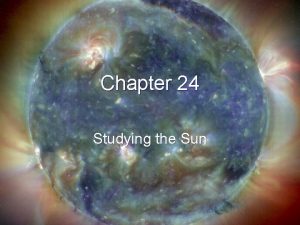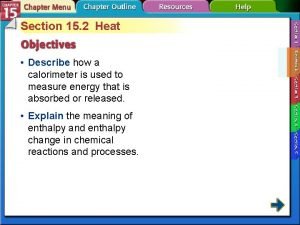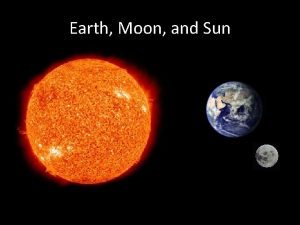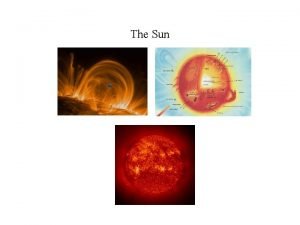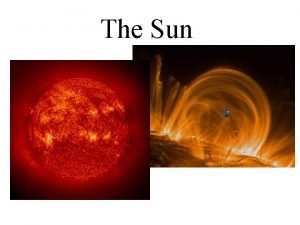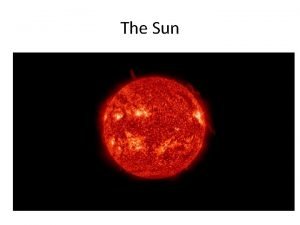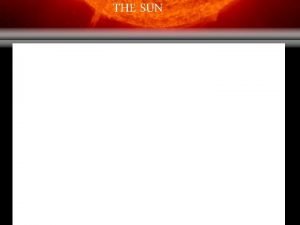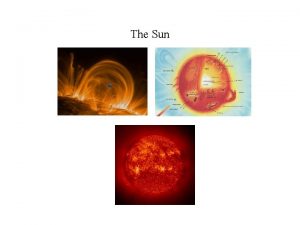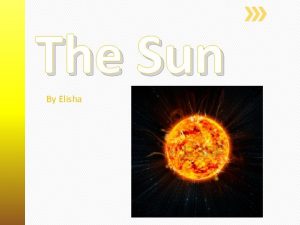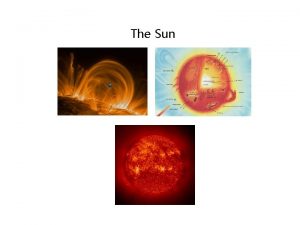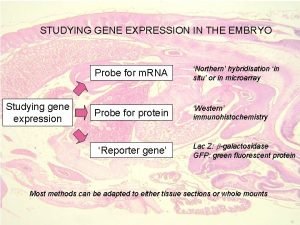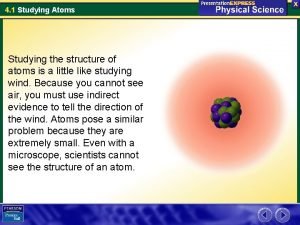Studying the Sun The Sun The Sun The























- Slides: 23

Studying the Sun

The Sun

The Sun • The sun is one of the 100 billion stars that make up the Milky Way galaxy. • Compared to other stars, the sun is an “average star. ” • To us its gigantic: diameter is equal to 109 Earth diameters, or 1. 35 million times as great as Earth’s, but its density is ¼ of Earth.

Structure of the Sun • Because the sun is made of gas, no sharp boundaries exist between its various layers. • Keeping this in mind, we can divide the sun into four parts: – the solar interior; – the visible surface, or photosphere; – and two atmospheric layers, the chromosphere and corona.

Structure of the Sun

The visible surface of the sun is its A. B. C. D. Corona. Chromosphere. Photosphere. Prominence.

Structure of the Sun • Photosphere – The photosphere is the region of the sun that radiates energy to space, or the visible surface of the sun. – It consists of a layer of incandescent gas less than 500 kilometers thick. – It exhibits a grainy texture made up of many small, bright markings, called granules, produced by convection. – Most of the elements found on Earth also occur on the sun. – Its temperature averages approximately 6000 K (10, 000ºF).

Structure of the Sun Chromosphere • The chromosphere is the first layer of the solar atmosphere found directly above the photosphere. • It is a relatively thin, hot layer of incandescent gases a few thousand kilometers thick. • Its top contains numerous spicules, which are narrow jets of rising material.

Chromosphere

Structure of the Sun Corona • The corona is the outer, weak layer of the solar atmosphere. • The temperature at the top of the corona exceeds 1 million K. • Solar wind is a stream of protons and electrons ejected at high speed from the solar corona.

Streams of electrons and protons that shoot out from the sun’s corona are the solar A. B. C. D. Prominences. Channels. Chromosphere. Wind.

The Active Sunspots • A sunspot is a dark spot on the sun that is cool in contrast to the surrounding photosphere. • Sunspots appear dark because of their temperature, which is about 1500 K less than that of the surrounding solar surface.

Sunspots

Sunspots appear as darker areas on the sun’s surface because they are A. B. C. D. Hotter than the rest of the surface. Holes in the sun’s surface. Solid areas of the sun’s surface. Cooler than the rest of the surface.

The Active Sun Prominences • Prominences are huge cloudlike structures consisting of chromospheric gases. • Prominences are ionized gases trapped by magnetic fields that extend from regions of intense solar activity.

Solar Prominence

The Active Sun Solar Flares • Solar flares are brief outbursts that normally last about an hour and appear as a sudden brightening of the region above a sunspot cluster. • During their existence, solar flares release enormous amounts of energy, much of it in the form of ultraviolet, radio, and X-ray radiation. • • Auroras, the result of solar flares, are bright displays of ever-changing light caused by solar radiation interacting with the upper atmosphere in the region of the poles.

Aurora Borealis

Which of the following is an effect of solar flares on Earth? A. B. C. D. Bombards Earth with radio waves. Creates auroras. Makes the climate warmer. Causes the magnetic poles to reverse

The Solar Interior Nuclear Fusion • Nuclear fusion is the way that the sun produces energy. This reaction converts four hydrogen nuclei into the nucleus of a helium atom, releasing a tremendous amount of energy. • During nuclear fusion, energy is released because some matter is actually converted to energy. • It is thought that a star the size of the sun can exist in its present stable state for 10 billion years. As the sun is already 4. 5 billion years old, it is “middle -aged. ”

Nuclear Fusion

When the sun produces energy, it consumes hydrogen and produces A. B. C. D. Radium. Helium. Nitrogen. Chromium.

The sun can continue to exist in its present stabel stare for about another A. B. C. D. 1 billion years. 5. 5 billion years. 10 billion years. 15. 5 billion years.
 Chapter 24 studying the sun
Chapter 24 studying the sun Module 11 studying the brain
Module 11 studying the brain Edgar schein 3 levels of culture
Edgar schein 3 levels of culture A student is studying the ecology of a playa lake
A student is studying the ecology of a playa lake Lesson 1 studying geography
Lesson 1 studying geography Ancient greece stations
Ancient greece stations Studying
Studying Art talk chapter 2 review answers
Art talk chapter 2 review answers Uiuc swb
Uiuc swb Rakat of jummah
Rakat of jummah The five i's of studying microorganisms
The five i's of studying microorganisms Reasons for studying concepts of programming languages
Reasons for studying concepts of programming languages Researchers who are studying a new shampoo
Researchers who are studying a new shampoo Studying geography economics and citizenship
Studying geography economics and citizenship Section 1 studying viruses and prokaryotes
Section 1 studying viruses and prokaryotes A polysaccharide you are studying contains unbranched
A polysaccharide you are studying contains unbranched Importance of studying protostomes
Importance of studying protostomes Kendra is studying the energy pyramid shown
Kendra is studying the energy pyramid shown Studying in sweden as an eu citizen
Studying in sweden as an eu citizen What do ecologists study
What do ecologists study Studying
Studying Importance of studying population
Importance of studying population Benefits of studying in a quiet place
Benefits of studying in a quiet place Why are chemists interested in studying thermochemistry?
Why are chemists interested in studying thermochemistry?
